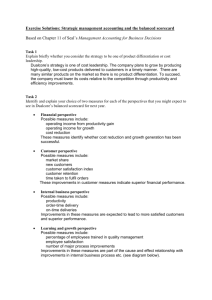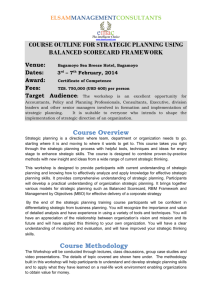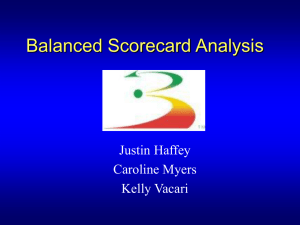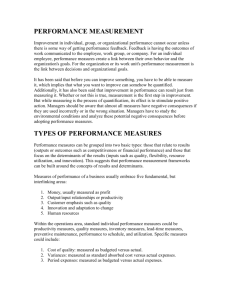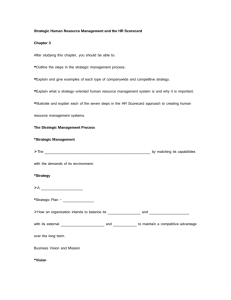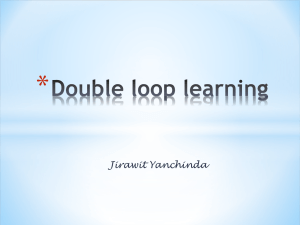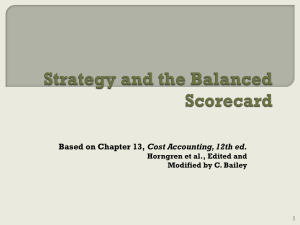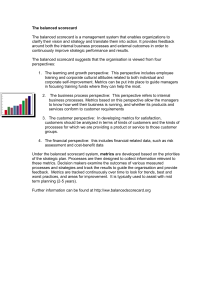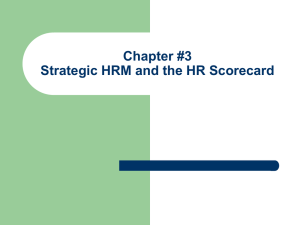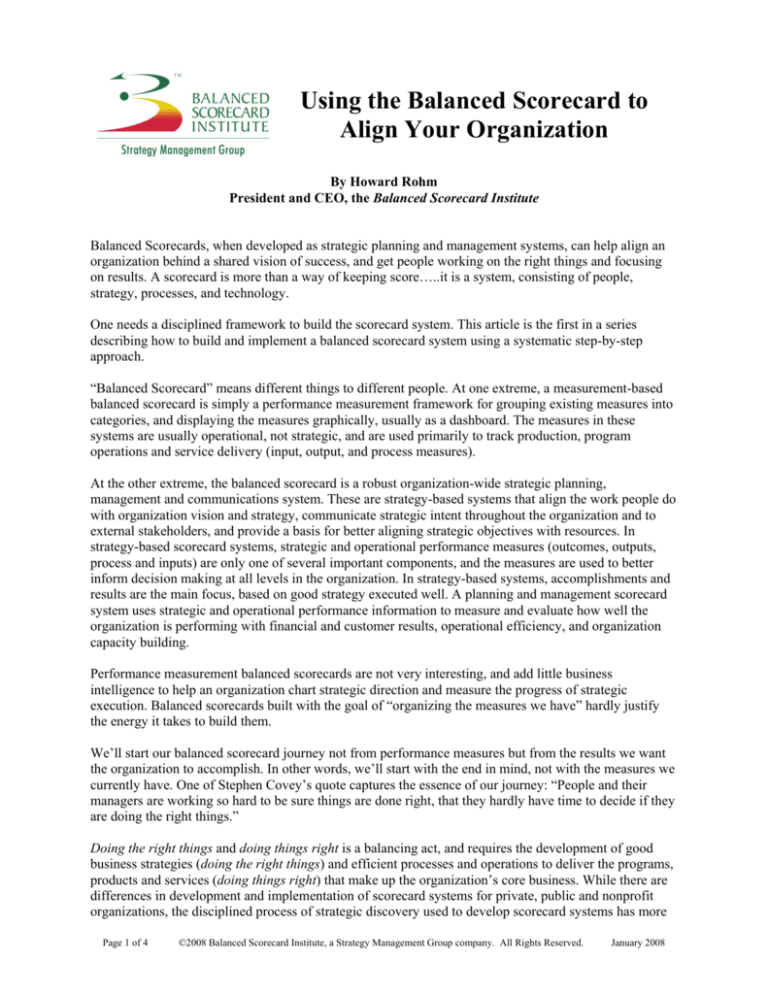
Using the Balanced Scorecard to
Align Your Organization
By Howard Rohm
President and CEO, the Balanced Scorecard Institute
Balanced Scorecards, when developed as strategic planning and management systems, can help align an
organization behind a shared vision of success, and get people working on the right things and focusing
on results. A scorecard is more than a way of keeping score…..it is a system, consisting of people,
strategy, processes, and technology.
One needs a disciplined framework to build the scorecard system. This article is the first in a series
describing how to build and implement a balanced scorecard system using a systematic step-by-step
approach.
“Balanced Scorecard” means different things to different people. At one extreme, a measurement-based
balanced scorecard is simply a performance measurement framework for grouping existing measures into
categories, and displaying the measures graphically, usually as a dashboard. The measures in these
systems are usually operational, not strategic, and are used primarily to track production, program
operations and service delivery (input, output, and process measures).
At the other extreme, the balanced scorecard is a robust organization-wide strategic planning,
management and communications system. These are strategy-based systems that align the work people do
with organization vision and strategy, communicate strategic intent throughout the organization and to
external stakeholders, and provide a basis for better aligning strategic objectives with resources. In
strategy-based scorecard systems, strategic and operational performance measures (outcomes, outputs,
process and inputs) are only one of several important components, and the measures are used to better
inform decision making at all levels in the organization. In strategy-based systems, accomplishments and
results are the main focus, based on good strategy executed well. A planning and management scorecard
system uses strategic and operational performance information to measure and evaluate how well the
organization is performing with financial and customer results, operational efficiency, and organization
capacity building.
Performance measurement balanced scorecards are not very interesting, and add little business
intelligence to help an organization chart strategic direction and measure the progress of strategic
execution. Balanced scorecards built with the goal of “organizing the measures we have” hardly justify
the energy it takes to build them.
We’ll start our balanced scorecard journey not from performance measures but from the results we want
the organization to accomplish. In other words, we’ll start with the end in mind, not with the measures we
currently have. One of Stephen Covey’s quote captures the essence of our journey: “People and their
managers are working so hard to be sure things are done right, that they hardly have time to decide if they
are doing the right things.”
Doing the right things and doing things right is a balancing act, and requires the development of good
business strategies (doing the right things) and efficient processes and operations to deliver the programs,
products and services (doing things right) that make up the organization’s core business. While there are
differences in development and implementation of scorecard systems for private, public and nonprofit
organizations, the disciplined process of strategic discovery used to develop scorecard systems has more
Page 1 of 4
©2008 Balanced Scorecard Institute, a Strategy Management Group company. All Rights Reserved.
January 2008
similarities then differences, so the framework we will describe applies equally well to different types of
organizations, as well as to different size organizations. We have applied the framework to businesses,
nonprofits, and government organizations with less than 10 employees to organizations with more than
100,000.
Developing a balanced scorecard system is like putting a puzzle together, where different pieces come
together to form a complete mosaic. In the balanced scorecard, the “pieces” are strategic components that
are built individually, checked for “fit” against other strategic components, and assembled into a complete
system. The major components of a balanced scorecard system are shown in the table below, and
summarized briefly in the paragraphs that follow. Future newsletter articles will explore each of the major
system components and describe how each piece of the puzzle is build and connected to other pieces.
Engaged Leadership
Interactive Communications and Change
Management
Vision and Mission
Core Values
Organization Pains and Enablers
Customers and Stakeholders
Customer Value Proposition
Strategy (Perspectives, Strategic Themes, and
Strategic Results)
Strategic Objectives
Customer-Facing Value Creation Strategy
(Strategy Map)
Performance Measures, Targets and Thresholds
Strategic Initiatives
Performance Information Reporting
Department and Individual Scorecards (Cascade)
Rewards and Recognition Program
Evaluation
Table 1: Balanced Scorecard System Elements
Engaged Leadership, Interactive Communications and Change Management. Developing a scorecard
system is transformational for an organization….it’s about changing hearts and minds. Leaders who are
engaged in the discovery process, communication via two-way dialogue, and planning and managing
change are important first steps in the process.
Organization Mission, Vision, and Values. Critical to an aligned organization are a well defined mission, a
shared vision, and organization values that are built on strong personal values. Most organizations have
these components, but often there is no connecting tissue among the components that allow employees to
“get it” easily. A compelling and clear “picture of the future” (the shared vision) is where the scorecard
development process starts……employee buy-in follows as hearts and minds are engaged in creating and
executing the organization’s strategies.
Organization Pains (Weaknesses) and Enablers (Strengths). An organization environmental scan (“climate
survey”) will identify internal and external pains and enablers that will drive strategy creation and the
approach to achieving future results.
Customers and Stakeholders, and the Value Proposition. Effective strategy incorporates a view from the
customer and stakeholder perspective, and includes an understanding of customer needs, product and
service characteristics, desired relationships and the desired “corporate image” that the organization wants
to portray.
Perspectives, Strategic Themes, and Strategic Results. To view strategy through different performance
lenses (balanced scorecard perspectives), the organization needs to define strategic perspectives, key
strategies and expected results. Key strategies are the main focus areas or “pillars of excellence” that
translate business strategy into operations, and make strategy actionable to all employees.
Strategic Objectives and Strategy Map. Strategic objectives are the building blocks of strategy (strategy
“DNA”), and objectives linked together in cause-effect relationships create a strategy map that shows how
an organization creates value for its customers and stakeholders.
Page 2 of 4
©2008 Balanced Scorecard Institute, a Strategy Management Group company. All Rights Reserved.
January 2008
Performance Measures, Targets and Thresholds. Performance measures are linked to objectives and allow
the organization to measure what matters and track progress toward desired strategic results. Targets and
thresholds provide the basis for visual interpretation of performance data, to transform the data into
business intelligence.
Strategic Initiatives. Initiatives translate strategy into operational terms, and provide a basis for
prioritizing the budget and identifying the most important projects for the organization to undertake.
Performance Information Reporting. Automated data collection and reporting processes are used to
visualize performance information and better inform decision making throughout the organization.
Cascade Scorecards to Departments and Individuals. Align the organization through strategy, using the
strategy map, performance measures and targets, and initiatives. Scorecards are used to improve
accountability through objective and performance measure ownership.
Rewards and Recognition. Incentives are tied to performance to make strategy actionable for people, and
help build buy-in for the behavior changes needed to create a high-performance organization.
Evaluation. The results of the organization becoming more strategy-focused are evaluated, and changes in
strategy, measures, and initiatives reflect organization learning.
Each scorecard component is developed in a logical sequence, using a disciplined framework of discovery
and strategic thinking. Our framework, Nine Steps to Success™, is shown in the figure below. Each step
links to another step until the complete scorecard system is developed.
Building & Implementing A Balanced Scorecard
System: Nine Steps To Success™
•• BSC
BSC Development
Development Plan
Plan
•• Strategic
Strategic Elements
Elements
•• Change
Change Management
Management
•• Strategy
Strategy Results
Results
•• Revised
Revised Strategies
Strategies
•• Customer
Customer Value
Value
•• Strategic
Strategic Themes
Themes
•• Strategic
Strategic Results
Results
Customer
Financial
Mission
Vision
Internal
Processes
•• Strategy
Strategy Action
Action
Components
Components
•• Alignment
Alignment
•• Unit
Unit &
&
Individual
Individual
Scorecards
Scorecards
Organization
Capacity
•• Software
Software
•• Performance
Performance
Reporting
Reporting
•• Knowledge
Knowledge
Sharing
Sharing
••Cause-Effect
CauseCause-Effect Links
Links
•• Strategic
Strategic Projects
Projects
•• Performance
Performance Measures
Measures
•• Targets
Targets
•• Baselines
Baselines
© 2007 by the Balanced Scorecard Institute, a Strategy Management Group company. All rights reserved.
Figure 1: Balanced Scorecard Nine Steps to Success™ Framework
Following development of the strategic components, the scorecard system is assembled and
communicated throughout the organization. The figure below shows one graphical representation of how
key components of a finished scorecard system are connected together to form a strategic plan for moving
the organization to a higher level of performance.
Page 3 of 4
©2008 Balanced Scorecard Institute, a Strategy Management Group company. All Rights Reserved.
January 2008
Association Balanced Scorecard
Mission: Serve our members with strong advocacy, quality information, and
responsive member services
Vision: Continue building on our unique position -- the only research association
serving an international membership
Strategy Map
Members
Financial/
Stewardship
Internal
Business
Processes
People,
Tools, &
Organization
Capacity
Increased
Advocacy
Results
Value for
Money
Strategy
components
to achieve
success
How the
strategy will
be measured
and tracked
The level of
performance
improvement
needed
Programs
required to
achieve
objectives
Economics
of
Membership
Image
Relationship
Objectives Measurement
Increase
Advocacy
Process
Efficiency
Improved
Advocacy
Planning
Improve
Information
Quality, Quantity,
& Timeliness
Improve
Knowledge
Of Member
Needs
Improve
Skills
Mix
• Improved
Advocacy
Planning
• Plan
acceptance
rate by
members
• Time spent
with policy
makers
Target
• 85 %
• 20%
Initiative
• Develop
advocacy
database
• Develop
new,
innovative
programs
Improved
Capacity to
Respond
Improve
Tools
Create
“We”
Culture
© 2007 by the Balanced Scorecard Institute, a Strategy Management Group company. All rights reserved.
Figure 2: Example Balanced Scorecard Graphic
In this example, the scorecard system includes a strategy map, to show how value is created for members
(customers), strategic objectives to describe what needs to be accomplished to produce value, what
performance measures will be used to measure progress against targets, and what strategic initiatives have
been identified to make strategy actionable and operational.
Developing a balanced scorecard is a journey, not a project. The real value of a scorecard system comes
from the continuous self-inquiry and in-depth process of discovery and analysis that is at the heart of the
process. Start your balanced scorecard with the idea that you are in it for the long term, and that you will
learn a lot about how your organization needs to work to satisfy customers, stakeholders, and employees.
How long does it take to build a scorecard system? Depending on the size of the organization, two to four
months is typical. In later articles, we will explore each of the steps involved in developing a scorecard
system, and discuss how to use and mange the system to improve your organization’s performance.
Howard Rohm is President and CEO of the Balanced Scorecard Institute, and is an international trainer, educator,
consultant, and facilitator. Howard developed the Institute’s Nine Steps to Success™ balanced scorecard framework
in 1997. He has 40 years of experience in industry, government, and nonprofit organizations. He can be reached at:
(919) 460-8180, or via email at: hhr@balancedscorecard.org.
The Balanced Scorecard Institute, a Strategy Management Group company, helps organizations succeed through
improved strategic focus and performance by providing training and consulting services related to best practices in
balanced scorecard (BSC), strategic performance management and measurement, and transformation and change
management. You can reach the Institute at: info@balancedscorecard.org or through the number one balanced
scorecard site on the internet: www.balancedscorecard.org
Page 4 of 4
©2008 Balanced Scorecard Institute, a Strategy Management Group company. All Rights Reserved.
January 2008

